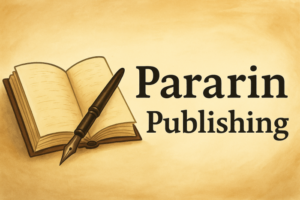
Pararin Publishing

The Art of Haunting Atmosphere
The Art of Haunting Atmosphere: Why Every Writer Needs to Master Fear in Their Novel
When it comes to writing a novel that lingers in the reader’s mind, plot alone won’t cut it. A twist is exciting, but it fades. Characters? Important, but even the best protagonist needs more than a backstory to feel alive. What truly haunts a reader long after the final page is atmosphere. And not just any atmosphere—we’re talking about the kind that curls around the edges of your story, fills the silences between dialogues, and clings to the bones of every scene. This is the art of haunting atmosphere, and if you’re a writer who wants your novel to stand out, it’s a craft you can’t afford to ignore.
Forget jump scares. Forget sudden loud noises and cheap thrills. The kind of fear that works in a novel is deeper than that. It’s the dread that builds so slowly you barely notice it until you’re holding your breath. It’s the stillness that feels too still. It’s the quiet creak in a room where no one should be. The art of haunting isn’t just about horror; it’s about presence. And this book, The Art of Haunting Atmosphere, is for every writer who wants to turn silence into suspense, and suggestion into sensation.
A great writer knows how to describe a room. A haunting writer makes you feel like you’re being watched inside it. That’s the difference. In the pages of this guide, you’ll find not only explanations but provocations—challenges that demand you to stop writing safe and start writing unforgettable. We’re not here to ask you to write darker. We’re here to help you write deeper. To show you how fear, tension, and ambiguity can become tools just as powerful as dialogue and pacing.
One of the most powerful things this book teaches is how to turn emptiness into meaning. An empty hallway isn’t just a hallway—it’s a question. Who’s been there? What happened? Why is it so quiet? A writer who can load silence with weight is a writer who controls the reader’s pulse. And that control is what sets a decent novel apart from the one readers can’t put down.
Another key lesson? Rhythm. Not sentence rhythm, but emotional rhythm. The way fear rises and falls. The way tension gives way to brief relief, only to tighten again. Like breathing. Like a heartbeat. A novel with haunting atmosphere doesn’t hold readers with action—it holds them with anticipation. That slow-burn energy is what makes scenes stay. You don’t need to show the monster. Sometimes it’s scarier when the reader only thinks they saw it.
This book is filled with examples, exercises, and insider techniques that help any writer—whether you’re just starting your first novel or polishing your tenth—to build mood and tone with surgical precision. It pushes you to stop thinking of scenes as places where things happen, and instead as places where feelings live. A forest isn’t scary because it’s dark. It’s scary because someone disappeared there, and no one knows why. A house doesn’t need ghosts to be haunted. It just needs memories the reader can feel in the floorboards.
But this book doesn’t just tell you how to write fear. It shows you how to feel it. Through writing drills that sharpen your instincts, you’re not just told to “build suspense” or “create tension.” You’re dropped into it. You’re asked to sit with it. You’re made to write your way out of it. These aren’t writing prompts. They’re provocations. They provoke memory, doubt, discomfort. And through that, they sharpen your skills.
In a market saturated with content, the novels that stand out are the ones that dare to leave a mark. This doesn’t mean more gore, more screams, more shadowy figures. It means more emotional risk. It means writing scenes that feel dangerous not because of what’s happening, but because of what might. It means treating every setting like a character. Giving your world its own heartbeat.
And that’s why every writer who wants their novel to be more than entertainment needs to master the art of haunting atmosphere. It’s not just about fear. It’s about control. It’s about resonance. It’s about crafting stories that follow your reader home.
If you’re a writer who wants to go beyond plot and enter the realm of experience, this book is your next step. Whether you’re writing horror, thriller, psychological drama, or even literary fiction, the techniques inside The Art of Haunting Atmosphere will teach you how to create scenes that feel real, characters who seem to linger, and stories that haunt long after the final word.
Because unforgettable novels don’t just entertain. They haunt. And the writer who knows how to haunt… never gets forgotten.
บทความน่าอ่าน
Pararin Publishing ตั้งใจเขียนทุกบทความให้คุณได้อ่านแบบไม่มีโฆษณากวนใจ
เพราะเราอยากให้คุณได้อ่านบทความดี ๆ อย่างเต็มที่ ถ้าคุณรู้สึกว่าเนื้อหาของเรามีคุณค่า
สนับสนุนเราได้ด้วยการซื้ออีบุ๊ค หรือร่วมสมทบตามใจคุณ
เพราะทุกการสนับสนุนของคุณ คือพลังที่ทำให้เราสร้างเนื้อหาดี ๆ ได้ตลอดไป
บทความ เทคนิคการเขียนฉากหลอน และความตื่นเต้น สำหรับการเขียนนิยายและบทภาพยนตร์
นักเขียนที่อยากให้คนอ่านรู้สึก “กลัวแบบอยู่ในนั้นจริง ๆ” ต้องเริ่มตรงไหน?
เขียนนิยายให้หลอน ตื่นเต้น และคนอ่านไม่กล้าปิดหนังสือ: เทคนิคที่ไม่ใช่แค่ “กลัว”
นิยายที่ทำให้คนอ่านรู้สึกกลัว ต้องกลัวจากข้างใน ไม่ใช่เพราะมีผีโผล่มาตกใจ
อยากให้คนอ่านนิยายกลัวจนวางไม่ลง ต้องไม่เขียนแบบคนไม่รู้สึกอะไร
ถ้านิยายของคุณไม่มีแรงดึง คนอ่านจะหลุดออกจากเรื่องตั้งแต่ยังไม่ถึงหน้าที่ 10
นักเขียนที่อยากให้คนอ่านลืมหายใจ ต้องกล้าเขียนด้วยอารมณ์ที่กลัวจริง
นักเขียนกับภารกิจสั่นประสาท: เขียนยังไงให้ผู้อ่านกลัวแต่ไม่หนี
นักเขียนจะเขียนความกลัวให้น่ากลัวได้จริง ต้องกล้าดูความกลัวของตัวเองก่อน
กลิ่นหลอนที่แทรกอยู่ในนิยาย ไม่ใช่เสียงกรีดร้อง แต่คือจังหวะเงียบที่กดหัวใจ
ความกลัวในนิยาย ไม่ได้ซ่อนอยู่ในความมืด แต่มันซ่อนอยู่ในความจริงที่เราไม่กล้ายอมรับ

Pararin Publishing
เราทำหนังสือสำหรับคนที่กำลังตั้งคำถามกับชีวิต
ไม่ใช่เพื่อให้ได้คำตอบทันที แต่เพื่อช่วยให้ใจคุณค่อย ๆ มั่นคงขึ้นทีละนิด
หนังสือของเราอาจไม่ใช่ทางลัด แต่มันคือแสงไฟเล็ก ๆ ที่คุณจะได้หยิบติดมือไว้ ในวันที่เส้นทางมันมืดและเหนื่อย
บางเล่มอาจพูดถึงอดีตที่ยังค้างในใจ
บางเล่มอาจช่วยให้คุณเข้าใจความสัมพันธ์ที่เปราะบาง
บางเล่มอาจเป็นแค่บทสนทนาเงียบ ๆ ระหว่างคุณกับตัวเอง
เราเชื่อว่า การเยียวยาไม่จำเป็นต้องยิ่งใหญ่ บางครั้งแค่มีถ้อยคำที่พูดแทนใจได้ ก็พอแล้ว
Pararin Publishing – เราทำหนังสือเพื่อให้คุณยังเดินต่อไปได้…อย่างไม่ต้องเร่งรีบ
